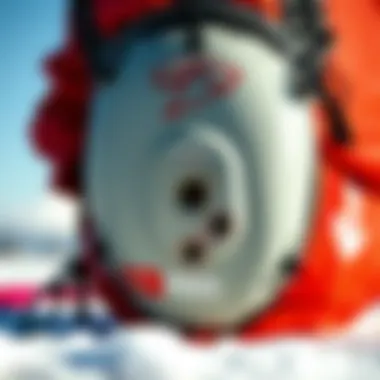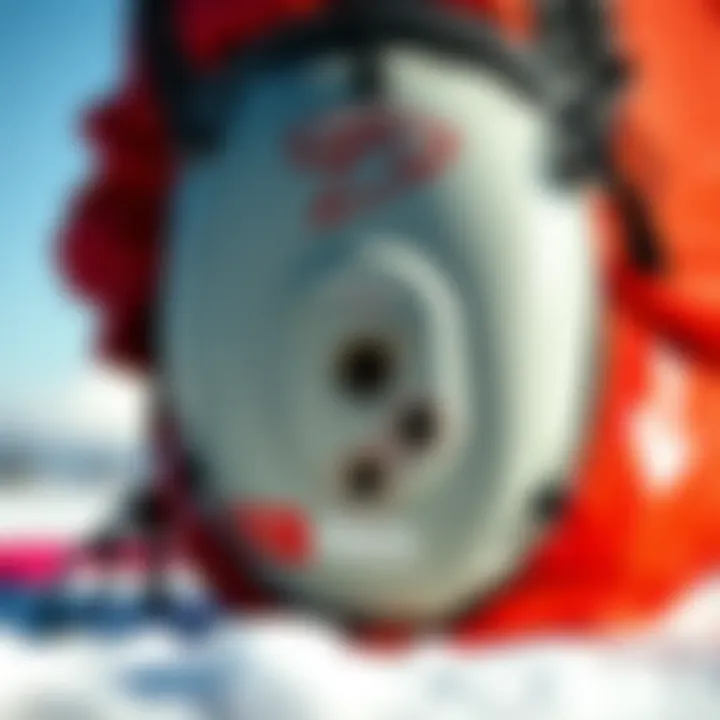Kite Bladder Replacement: A Complete Guide


Intro
Kiteboarding is both an art and a science, merging the thrill of surfing with the mastery of flying. For those who embrace this exhilarating sport, kite bladder replacement is a fundamental aspect of upkeep that can't be overlooked. The kite bladder, typically constructed from durable polyurethane, is crucial for keeping your kite inflated and airborne. When these bladders begin to lose their integrity, the joy of riding can quickly turn to frustration.
Understanding the importance of maintaining your gear allows for a more enjoyable and safe kiteboarding experience. Not only does this knowledge help ensure you’re riding with top-notch equipment, but it also empowers you with the skills to tackle repairs as they come up. Whether you’re a weekend warrior or a dedicated kiteboarding instructor, knowing how to assess the condition of your kites and replace the bladders can extend the life of your gear significantly.
As we dig into the details, we'll cover everything from the signs indicating a need for bladder replacement to the materials that work best for your kites. Our aim is to provide you with practical advice tailored specifically for kiteboarders, event organizers, and enthusiasts alike. Let’s shift our focus to the first major topic: Gear Selection.
Foreword to Kite Bladders
When it comes to kiteboarding, kite bladders play an instrumental role. These vital components ensure that the kite remains inflated, helping it catch the wind effectively. Without properly functioning bladders, even the best kite designs can't perform at their peak. Understanding the nuances of kite bladders not only helps in enhancing your skill on the water but also protects your investment in gear.
Understanding What Kite Bladders Are
Kite bladders are essentially inflatable, air-tight sacs that sit inside the outer canopy of a kite. They come in various shapes and sizes, but their primary function remains the same: they provide shape and structure, allowing the kite to lift off the ground and soar through the skies. Made from durable materials, bladders need to withstand pressure fluctuations and the elements. Many kite enthusiasts might not give them much thought, but understanding their construction can open up a world of knowledge about performance and maintenance.
For instance, the most common materials for kite bladders include polyurethane and PVC, each with its own set of pros and cons. Polyurethane is often lighter and more flexible, while PVC tends to be more durable against punctures. Knowing about these options can significantly impact your decision when purchasing or repairing your kite.
The Role of Bladders in Kite Performance
The performance of a kite is largely determined by how well its bladder maintains inflation. When the kite’s bladder is functioning properly, it ensures that the kite flies optimally, meaning better lift, agility, and control. However, if a bladder develops a leak or puncture, it can drastically alter how the kite behaves in the air. The pilot may notice reduced buoyancy, less responsiveness, and even difficulties in controlling the kite, particularly in tricky wind conditions.
It’s crucial for kiteboarders to regularly check their bladders for trouble spots and address any issues promptly. Frequent inspections can catch small leaks before they evolve into larger problems, ensuring you can enjoy your time on the water without unexpected surprises. In addition, proper inflation techniques can also affect overall performance. Riding with an under-inflated kite not only compromises flight but could also lead to an unexpected crash, causing potential damage to the kite and risking the rider’s safety.
In summary, kite bladders are fundamental to performance and safety. Recognizing the importance of these components helps caregivers ensure good maintenance practices and keeps kiteboarding enjoyable.
Importance of Maintaining Kite Bladders
Maintaining kite bladders is a pivotal aspect of kiteboarding that often gets overlooked, yet it plays a monumental role in ensuring performance and safety on the water. Kite bladders are essentially the inflatable components that keep your kite aloft and its structure intact. When these bladders succumb to wear and tear, the entire kite's functionality is compromised. Therefore, understanding the importance of maintaining these vital parts cannot be understated; failure to do so can lead to not only diminished performance but also potentially hazardous situations.
Impact on Performance and Safety
When it comes to kiteboarding, every little detail counts, especially concerning the integrity of your equipment. The bladder's primary function is to create the necessary shape and volume to capture wind effectively. If a bladder begins to leak or becomes damaged, the kite will not perform as intended, leading to reduced lift, stability, and responsiveness.
Moreover, a malfunctioning bladder can put you at serious risk. A sudden loss of pressure can lead to unpredictable flying behavior, which can be particularly dangerous in challenging wind conditions. According to many kiteboarders, maintaining kite bladders is not just about performance—it's a matter of safety.
“It’s incredible how much of a difference a well-maintained bladder can make—having your kite perform as it should is like having your car hit every gear smoothly.”
In summary, a kite with a compromised bladder can behave erratically in the air, contrasting sharply with a well-maintained one that remains controllable and easy to handle. Hence, a diligent approach to maintenance will not only enhance your performance but also help prevent accidents that could lead to injury.
Longevity of Physical Components
The longevity of kite components hinges largely on how well they are maintained over time. Bladders, in particular, are often subjected to harsh conditions that can take a toll—exposure to UV rays, saltwater, and even potential punctures from rough landings can all contribute to their degradation.
By regularly checking and maintaining your kite bladders, you minimize the chances of having to replace them prematurely. This can save you a significant amount of money in the long run, especially when you consider the cost of new bladders, labor for repairs, or the potential loss incurred from damaged gear. Furthermore, well-maintained bladders can enhance the overall performance of the kite, extending its usability and enjoyment.
To keep your kite bladders in top shape, engage in simple routine checks such as:
- Inspecting for visible damage, like tears or punctures.
- Checking inflation to ensure a firm, stable shape.
- Cleaning the bladder post-use to eliminate salt and sand buildup.
In essence, the effective maintenance of your kite's bladders not only promises a longer life for the equipment but also assures that you will enjoy a more fulfilling kiteboarding experience.
Signs That Indicate Bladder Replacement is Needed
Understanding when a kite bladder needs replacement is crucial for maintaining kite performance and safety. Kitebladders are integral to the structure and functionality of a kite, serving not just to hold air, but also adding to the kite's overall shape and stability in the skies. Without appropriate attention to their condition, kite enthusiasts could face serious performance issues or even accidents.
Visual Damage and Wear
One of the most straightforward indicators that a replacement is necessary is visible damage or wear. Inspecting your kite for any signs of deterioration should be a regular part of your pre-ride check. Look for:
- Cracks or tears: Even small fissures can grow and lead to a complete loss of air.
- Discoloration: Changes in color can hint at material fatigue due to prolonged exposure to sunlight.
- Bubbles or bulges: These can indicate that air is trapped in layers of the bladder, usually from a compromised seal.
In essence, when you spot visual defects, take it seriously; they often signal deeper issues.
Ignoring these issues can lead to more extensive repairs and even catastrophic failures during a kite session. Look over your kite bladder as often as you check the wind conditions; if something seems off, it's worth investigating further.
Loss of Pressure and Inflation Issues
Another warning sign is the kite's inability to maintain pressure when inflated. A properly functioning bladder should feel firm and stable. When you notice a kite losing air quickly or not inflating fully, there may be hidden issues that require intervention. Here are some specific things to check for:
- Rapid deflation: If your kite seems to lose air faster than expected, this might point to small punctures or significant leaks.
- Inconsistent inflation: Sometimes, parts of the kite may inflate unevenly, suggesting there’s a blockage or rupture in the bladder.
To determine if the issue lies with the bladder, try the following:
- Inflate the kite and listen for hissing sounds which indicate escaping air.
- Submerge the inflated kite in water to see if bubbles emerge; this can pinpoint the exact location of a puncture.
Addressing air pressure problems quickly can save you from missing out on a ride or risking your safety. Thus, staying alert and responsive to these signs is key for kiteboarding enthusiasts.
Materials for Kite Bladder Replacement
When it comes to maintaining the performance and safety of your kite, the materials you choose for bladder replacement can make a world of difference. Using the right kind of material not only ensures better performance but also enhances the durability of your equipment. Kite bladders undergo significant stress during usage, exposed to wind, water, and UV light. Thus, the material's resistance to these elements is crucial. Moreover, a good material will help control the shape and inflation of the kite, significantly impacting its overall flight characteristics.
Types of Materials Available
Kite bladder materials vary widely, each offering its unique properties. Here are a few commonly used materials:
- Polyurethane (PU): This material has gained popularity for its durability and resistance to tearing. PU bladders tend to have good elasticity, which allows them to hold air longer compared to other types.
- PVC (Polyvinyl Chloride): Often known for being economical, PVC can withstand a decent amount of wear, but its long-term performance falls short of PU. It can be less effective in maintaining pressure over time, leading to potential flight issues.
- Neoprene: Known for its excellent flexibility, neoprene can adapt to various shapes and sizes of bladders. This material also provides good insulation from the cold water, keeping the air inside warmer for increased buoyancy.


It might interest you that some kites feature a combination of these materials, blending their strengths to enhance performance and durability.
Choosing the Right Material for Your Kite
Selecting the appropriate material doesn't merely boil down to availability or price; it requires careful consideration of your kiteboarding style and usage conditions. Here are some factors to weigh:
- Frequency of Use: If you're an avid kiteboarder hitting the waves regularly, opt for materials like polyurethane that withstand wear and tear better than budget options.
- Environmental Factors: Depending on whether you’re in a freshwater lake or coastal saltwater, the choice of material can influence longevity. Saltwater can prematurely degrade lower-quality plastics, so it’s smart to invest a bit more for durable options.
- Weight and Performance: Lighter materials can enhance the performance of your kite, but they might not offer the same durability. Striking that perfect balance between weight and strength is key.
Remember, a well-chosen bladder material can elevate your kiteboarding experience by ensuring your kite maintains its shape and performance through challenging conditions.
In summary, the materials you select for kite bladder replacement play a critical role in the performance and longevity of your kite. From polyurethane to PVC, the right choice can protect your investment and enhance your time on the water.
Tools Required for Kite Bladder Replacement
When diving into the world of kite bladder replacement, understanding the tools alloted for the task sets the foundation for a smooth and effective process. In this article, the spotlight is on what items you’ll need to make this repair not just possible, but successful. Having the right tools can make a world of difference in the outcome and longevity of your kite.
Essential Tools for the Job
Every job has its toolbox, and kite bladder replacement is no different. Here's a closer look at the must-have tools for this task:
- Scissors - Precision is key. A sharp pair of scissors will allow you to cut bladder material cleanly, preventing any tearing that could cause future leaks.
- Measuring Tape - Accurate measurements are vital. A flexible measuring tape lets you get exact dimensions of your old bladder, ensuring the new one fits just right.
- Heat Gun or Iron - For bladders made from certain materials, sealing edges with heat can be essential. This equipment will help you melt and bond seams securely.
- Pressure Gauge - Maintaining correct pressure is pivotal for kite performance. A pressure gauge will ensure that your new bladder inflates properly.
- Pliers - Handy for removing stubborn fittings or connectors, pliers help cut through tough materials without too much hassle.
- Adhesive - Depending on the type of material your new bladder is made from, having a strong adhesive could be necessary for repairs and securing seams.
These pieces work in tandem; without one, the job could become a difficult slog. Thus, equipping yourself with the right tools sets you up for success from the get-go.
How to Use Each Tool Effectively
Getting the most out of each tool is crucial. Here’s how to handle them for maximum efficiency:
- Scissors: Always use scissors to cut bladder material in a straight line. This will reduce jagged edges that could lead to leaks. Keep them sharp and clean to make your cuts precise.
- Measuring Tape: Measure twice, cut once. Use the measuring tape to find the dimensions of your old bladder, ensuring you replicate those measurements as closely as possible with your new material.
- Heat Gun or Iron: For best results, keep your heat source moving to avoid spots that may overheat, weakening the material. Test a small section first to figure out the best temperature to use.
- Pressure Gauge: After inflating the bladder, check the gauge to ensure it matches the manufacturer’s recommended pressure. This verifies that you're on the right track for peak performance.
- Pliers: Use pliers to grip firmly without tearing, especially when dealing with metal fittings or connectors. They assist in getting a good hold without damaging your equipment.
- Adhesive: Apply it evenly on the surfaces to be bonded, and press them together. Give it time to cure before inflating the bladder to ensure a strong bond.
By mastering the usage of your tools, you not only enhance your efficiency but also reduce the risk of mishaps that can occur due to improper handling. Taking the time to understand these tools leads to a job well done – no ifs, ands, or buts about it.
"A job worth doing is worth doing well." - a saying often echoed within many crafts.
Equipped with the right tools and the knowledge of how to use them, you're now on the path to ensuring that your kite bladder replacement is as seamless as possible. Next, you’ll be ready to tackle the important aspects of removing that old bladder with confidence.
Step-by-Step Process for Bladder Replacement
Understanding the step-by-step process for bladder replacement is pivotal for maintaining the performance and safety of your kite. It’s not just about swapping old for new; it’s about ensuring that each step is performed meticulously to avoid complications down the line. Diving deep into this process enhances your kiteboarding experience, reinforcing your confidence while you're out on the water.
Preparing Your Kite for Replacement
Before you get your hands dirty, preparation is key. Start by securing a clean, spacious workspace. If possible, work indoors or under a covered area to avoid debris getting into your kite.
- Gather Your Tools: Make sure you have all necessary tools within reach. This includes scissors, patching material, adhesive, and more.
- Inspect the Kite: Take a good look at the entire kite, focusing on areas near the bladder. Check for any additional damage that might need attention.
- Release Air Pressure: Safely deflate your kite’s bladder before removal. This will make the process easier and safer.
- Document the Setup: If you’re a first-time user, snapping some photos of how the current bladder sits can be invaluable for later reference.
By prepping correctly, you set yourself up for a smoother replacement process.
Removing the Old Bladder
With everything ready, start disconnecting the old bladder. This can sometimes be tricky, requiring patience and finesse.
- Locate the Seams: Identify how the bladder is attached by checking the seams that connect it to the kite. Usually, these are secured with tape or velcro.
- Detach Carefully: Gently peel away any adhesive or tape. Avoid using excessive force, as this could damage the surrounding material of the kite.
- Extract the Bladder: Once detached, slowly pull the bladder out from its pocket. Be mindful of your kite's structure while doing this.
Properly removing the old bladder prevents unnecessary damage to the kite.
Installing the New Bladder
Now the fun part: installing your new bladder. It’s like giving your kite a brand new heart.
- Insert the New Bladder: Carefully slide your new bladder into the designated pocket. Ensure it's positioned correctly, as outlined by your photos from earlier.
- Seal the Edges: Depending on the type of bladder you have, use the appropriate adhesive to secure the bladder edges. If your bladder uses tape, apply it uniformly to avoid air leaks.
- Reattach Seams: Once the bladder is in place, ensure that all seams are properly connected, mirroring the original setup.
It’s essential to follow these steps meticulously to ensure the bladder's efficacy in maintaining shape and performance.
Testing and Final Adjustments
You wouldn’t hop in a car without checking the engine, right? The same logic applies here when checking your kite post-installation.
- Inflate the Bladder: Inflate your new bladder slowly and inspect for leaks or irregularities. Listen for any hissing sounds that might indicate air escaping.
- Check for Proper Shape: Lay the kite flat and examine its overall shape. It should appear symmetrical and free from wrinkles.
- Perform a Dry Run: If possible, take the kite for a test flight. Monitor how it performs, paying attention to responsiveness and control.
"Proper testing ensures that you aren’t caught off guard when you’re out on the water."
With these steps completed, you can expect improved performance matched with peace of mind. Your kite is once again ready to carve up the winds!
Common Mistakes to Avoid
In the world of kiteboarding, attention to detail can make or break one’s experience on the water. When it comes to replacing kite bladders, steering clear of common pitfalls is essential for ensuring performance, safety, and longevity of your gear. Below are three primary mistakes to avoid, each carrying significant consequences if overlooked.
Overlooking Damage Before Replacement
It may seem like a no-brainer, but assessing your existing kite bladder for damage before proceeding with a replacement is often brushed aside. Ignoring localized tears, fractures, or even just signs of stress can lead to choosing a replacement bladder that won’t mesh well with your kite’s structure or performance demands. A thorough inspection might reveal problems you didn’t even consider, like potential leaks that could worsen with time. This could mean a mid-session mishap when you least expect it.
When you’re looking at your bladder, a darkened or irregular patch should raise a red flag. These traits can indicate material fatigue or substandard integrity. Take time to inspect both the bladder and the surrounding casing. Don’t be in a rush to replace; instead, scrutinize.
Using Incompatible Materials
Not all materials are created equal, especially when it comes to kite bladder replacement. It can be tempting to choose cheaper alternatives, but this could backfire quickly. Many kites are designed to perform with specific materials that suit their intended conditions and intended use. For example, if you opt for a basic PVC material for an advanced kite engineered for high-performance riding, you may quickly encounter issues with inflation, pressure stability, or even overall shredding.
When sourcing materials, always consult manufacturer guidelines to find out which types work best for your specific kite model. Mismatched materials may lead to a dismal performance in the air, compromising the feel and handling that many kiteboarders love. Consider looking up reviews on reddit.com and forums specializing in kiteboarding to get practitioners' opinions on various material choices from real-world experience.


Neglecting Proper Inflation Techniques
Proper inflation is the lifeblood of your kite's performance. Even after you have successfully replaced your bladder, neglecting this critical step can spell disaster. If done hastily or incorrectly, the bladder may not hold air effectively, leading to a disjointed experience on the water.
From the first inflation to the last, focus on achieving proper pressure throughout your kite. Overinflation may lead to burst bladders, while underinflation can result in lackluster performance or even catastrophic failure when you’re airborne. Consider using a pressure gauge to ensure consistency each time you prepare to hit the waves.
Keeping these pointers in mind as you navigate the intricacies of bladder replacement will ultimately enhance your kiteboarding experience, reduce hassle, and keep your gear in top shape. For practical resources, you might check out articles on en.wikipedia.org pertinent to material types, or discussions on facebook.com dedicated to kite maintenance tips.
When to Seek Professional Help
When the time comes for a kite bladder replacement, not all situations are straightforward. Understanding when to call in a pro can make all the difference between a smooth ride and a murky experience on the water. The possibility of encountering issues that exceed your DIY expertise should not be underestimated. Knowing the right time to seek professional help is essential, ensuring both safety and performance during kiteboarding activities.
Identifying Complex Issues
Not every issue with a kite bladder is as clear-cut as it might seem. Sometimes, what appears as simple wear and tear can stem from underlying problems. For instance, if the kite isn’t holding air despite a proper inspection, it could be a symptom of bigger issues related to the stitching or the canopy fabric itself. One glaring sign is if you find persistent air loss or bubbles forming under the surface, which indicates that more than just the bladder may need attention.
Also, consider the age of your kite. If it’s an older model that’s seen plenty of action, it might be prudent to consult a professional. Often these seasoned enthusiasts have a wealth of experience with various brands and models and can provide insights into common problems.
While being handy is a valuable trait in this sport, knowing your limits is even more critical. If you hesitate on how to diagnose an issue, it’s wise to seek assistance. Mistakes can lead to significant complications, and an improperly replaced bladder can result in an unsafe experience on the water.
Finding a Reliable Repair Service
Now that you've made the decision to get professional help, the next challenge is sifting through available repair services. Finding the right one can often feel like searching for a needle in a haystack. What makes a repair service trustworthy?
First, do a bit of legwork. Look for reviews and testimonials. Direct feedback from fellow kiteboarders can shed light on their experiences. Websites like Reddit and Facebook can provide firsthand accounts from others who faced similar issues. Consider asking in forums as well; the kiteboarding community often shares wisdom and resources.
Second, ensure the service specializes in kite repair. Just because a shop fixes various sporting goods doesn’t mean they have the know-how for kites. You want a team that understands the complexities of the various kite brands, from the material types to the construction styles. Specialized services often offer warranties, which is a big plus in case the work doesn’t hold up.
- Ask About Their Process:
- Comparative Pricing:
- Do they offer inspections before committing to repairs?
- What materials do they use for replacements?
- Understand their pricing strategy. While it might be tempting to go for the cheapest option, balance cost with quality.
Finding the right service not only contributes to the longevity of your equipment but also provides peace of mind when hitting the waves. After all, you want to focus on enjoying the ride, not worrying about whether your gear will hold up.
Cost Implications of Bladder Replacement
When it comes to kiteboarding, having a well-functioning bladder is paramount. Not only does it affect performance, but the financial side of things is also worth discussing thoroughly. It’s easy to overlook the costs associated with kite bladder replacement when you’re excited about hitting the water. However, understanding the cost implications helps you plan better and avoid unexpected surprises down the line.
Cost implications can broadly influence decisions on what materials to choose, whether to DIY or hire a pro, and how much to set aside in your budget. Amid all the thrill of kitesurfing, keeping an eye on the purse strings can ensure you continue enjoying the sport without burning a hole in your wallet.
Budgeting for Replacement
Budgeting effectively is crucial when planning for bladder replacement. Here are some points to consider:
- Assessing Material Costs: Different bladder materials come with varying price tags. For example, a standard polyurethane might be cheaper than a higher-end thermoplastic. Knowing your options allows you to choose a bladder that meets both your performance needs and budget constraints.
- Setting Aside a Contingency Fund: It’s wise to keep a little extra cash aside. You never know what else might crop up during preparation or replacement. Setting aside 20% of your estimated costs can cover any unexpected issues.
- Maintenance Considerations: Maintaining your current bladder properly can save you money in the long run. Regular checks and proper storage can extend the lifespan of your bladder, reducing the frequency of costly replacements. Don’t scrimp on care; it often pays off.
Taking the time to create a budget prevents the last-minute rush when you need to replace your bladder. A well-planned budget can offer peace of mind.
Cost Comparison: DIY vs. Professional Services
Choosing between DIY and professional services is a pivotal decision. Here’s a structured breakdown:
- DIY Approach:A DIY bladder replacement can save you a bundle.
- Professional Services:Hiring a pro usually guarantees quality work.
- Material Costs: You’ll only pay for materials, which can often be cheaper than hiring someone.
- Tools Investment: If you don’t have the necessary tools already, you may need to invest in them, but this is often a one-time expense.
- Your Time: Factor in the time you’ll spend versus the savings gained. Will you enjoy this or consider it a chore?
- Labor Costs: Expect to pay for the expertise and time of the service provider.
- Piece of Mind: Knowing a professional handled your repair can be worth the extra cost, particularly if you are not confident in your skills.
"Sometimes you can’t put a price on safety and reliability, especially in action sports. Quality gear can save lives."
- Final Thoughts:
The choice largely hinges on your confidence level, budget, and timeframe. If you know your way around kites, a DIY replacement might suit you. But if fiddling with technical components feels daunting, investing in a professional could save you from future headaches. Whichever route you choose, understanding the costs and your own capabilities is essential for making an informed decision.
Durability and Maintenance of New Bladders
Kite bladders are crucial components that endure various stresses, from the fierce winds to the water impact, making the investigation into their durability and maintenance particularly pressing. Ensuring the longevity of your kite bladders is not just about performing regular check-ups; it’s about understanding how environmental factors, material quality, and proper care intertwine to affect performance and safety.
Maintaining your kite bladders ensures not just consistent performance but greater safety while engaging in kiteboarding activities. A well-maintained bladder can lead to optimal floatation and stability, making your rides more enjoyable while lowering the risk of unexpected failures. Moreover, the right maintenance practices translate into saving money over time, reducing the need for frequent replacements or repairs. Therefore, delving into the intricacies of durability and maintenance yields significant advantages for any dedicated kiteboarding enthusiast.
Understanding Durability Factors
The durability of kite bladders stems from several pivotal factors. Material selection stands foremost, as not all bladders are crafted equally. Some are made from robust polyester, while others may utilize lighter materials to reduce weight but may not hold up well under pressure. Both types have their merits, but understanding the application and conditions in which they will be used is important.
- Material Quality: Higher-quality materials can bear more stress, while cheaper options might suffer from faster wear and tear.
- Environmental Stressors: UV rays can cause deterioration in bladders not adequately protected during storage. Similarly, exposure to saltwater necessitates a rinsing routine after each session.
- Inflation Management: Over-inflating or under-inflating a bladder can affect its overall life. Adequate pressure should be maintained according to the manufacturer’s recommendations.
A well-rounded understanding of these factors is essential for making informed decisions about your gear and ensuring every outing is safe and enjoyable.
Routine Maintenance Practices
Like any sporting equipment, kite bladders require routine checks and care. Establishing a maintenance regimen may appear tedious, but it pays off in the long run. Here are some best practices:
- Regular Inspections: After every ride, give your bladder a visual check for any punctures or abrasions. Getting into this habit can prevent small issues from snowballing into major ones.
- Post-Session Rinsing: Rinse your kite with fresh water to remove salt and sand. Salt can corrode the material over time, weakening the bladder’s structural integrity.
- Proper Storage: Keep your kite bladders out of direct sunlight when not in use. Use a protective bag to shield them from dust and UV rays.
- Pressure Checks: Before each outing, ensure that the bladder is properly inflated. If it’s losing air, investigate any potential leaks. A well-inflated bladder increases stability, while a poorly inflated one can lead to mishaps.
- Repairs: If a bladder does get punctured, using a repair kit designed for your specific material can ensure a longer life for your gear.
> Maintaining the integrity of your kite bladders significantly enhances your safety and performance on the water. A little attention goes a long way!
By prioritizing these maintenance practices, kiteboarding enthusiasts can look forward to many exciting sessions without the nagging worry about bladder failure. Remember, consistent care translates to greater enjoyment out on the water.


Emphasizing Environmental Responsibility
As kiteboarding becomes increasingly popular, the importance of maintaining a healthy environment should not slip through the cracks. Kite enthusiasts frequently find themselves reveling in nature’s beauty, making it paramount to also take measures to protect it. When it comes to bladder replacement, there are several layers to consider regarding environmental responsibility, including materials used and disposal methods. Taking an eco-friendly approach not only enhances sustainability but also encourages a culture of conscious kiting.
Choosing Eco-Friendly Materials
When selecting materials for bladder replacement, prioritizing sustainable options holds significant value. Modern advancements have led to the emergence of materials that are both performance-oriented and environmentally friendly. You might consider materials like biodegradable TPU (thermoplastic polyurethane) or recycled polyester. Opting for these substitutes not only helps to reduce environmental impact but also supports manufacturers who are committed to minimizing waste.
- Benefits of Eco-Friendly Materials:
- Reduced carbon footprint
- Lower environmental toxicity
- Support for sustainable production practices
Moreover, some brands offer kite bladders made from recycled materials, which can significantly lessen the demand for new resources. As a bonus, many of these eco-materials don’t compromise on performance, ensuring that you can enjoy your sessions on the water with a clear conscience. It's all about striking that balance between performance and environmental friendly practices.
Responsible Disposal of Old Bladders
Recycling plays a crucial role in mitigating the environmental impacts associated with kiteboarding gear. When it's time to part ways with your old bladder, shedding light on responsible disposal methods is critical. Simply tossing the damaged bladder into the garbage can spell disaster for the ecosystem, contributing to landfills filled with non-biodegradable waste. Instead, look for local recycling programs specializing in materials like TPU or vinyl. Many communities have designated drop-off points for such items.
Additionally, some organizations focus on repurposing kite materials, allowing you to contribute positively while reducing your environmental footprint.
"Every kiteboarder should be conscious about their impact on the environment; it's not just about us riding the waves, but also protecting the oceans we love."
Being proactive about recycling can help create a more sustainable kiteboarding future. By making smart choices about both materials and disposal, kite enthusiasts can enjoy their sport while simultaneously safeguarding the environment for generations to come.
Case Studies on Bladder Replacement
The significance of exploring case studies in regard to kite bladder replacement cannot be overstated. These real-life examples provide a window into the practical applications of theories and techniques discussed throughout this guide. They reveal how different kiteboarders confront the inevitable wear and tear that comes with the sport and how they manage the challenges faced during bladder replacement. Understanding the narratives and experiences of others not only informs our practices but also inspires perseverance within our community.
The insights gleaned from these stories surface in two major areas: the success stories that uplift and encourage, and the lessons learned from failures that lead to better practices in the future.
Success Stories from the Kiteboarding Community
In the world of kiteboarding, sharing success stories often demonstrates not just personal victories, but also the triumph of knowledge and skill. Many kiteboarders have reported remarkable results after undertaking the task of bladder replacement.
For instance, take Sarah, an avid kiteboarder who found herself frequently battling deflation mid-session. After some investigation, she determined that her bladder needed replacing. With guidance from local kiteboarding shops and online forums, she opted for a lightweight, durable material known as TPU (thermoplastic polyurethane).
Sarah’s experience emphasizes a few crucial benefits after her bladder replacement:
- Performance Improvement: The new bladder maintained optimal pressure consistently, enhancing her responsiveness on the water.
- Enhanced Safety: No longer did she have to worry about sudden deflation during a jump, which drastically improved her confidence.
- Longevity of Equipment: Since she used quality materials, Sarah noted that her kite's overall health improved, leading to a longer lifespan for the entire gear.
Sarah's story became popular on social media, showing that with the right approach, bladder replacement can lead to significant enhancements in performance. Other enthusiasts resonated with her experience, and it prompted a wave of discussions regarding materials and techniques.
Lessons Learned from Failures
As informative as success stories are, lessons from failures often impart just as much wisdom. Not all replacements go smoothly, and these accounts can help others avoid making the same mistakes.
One notable case is that of Antonio, who jumped into replacing his old bladder without fully assessing the damage first. He opted for a DIY kit that wasn't compatible with his kite model. The outcome was far from ideal:
- Inconsistent Inflation: The new bladder didn't fit properly, leading to issues with maintaining pressure, much like a leaky tire.
- Frustrating Sessions: His time on the water was marred by repeated deflation, which disrupted his rhythm and progression.
- Additional Costs: What could have been a straightforward replacement turned into a costly endeavor as he needed to buy the right type of bladder on top of fixing his initial mistake.
Antonio’s misadventure serves as a cautionary tale. It underscores the need for thorough examination of both the kite and the materials before embarking on replacement. Notably, the community rallied around him, sharing advice on how best to prevent such situations, further highlighting the value of network support during challenging times.
These case studies not only enrich the understanding of bladder replacement practices but serve as valuable teaching tools. They demonstrate a dynamic interplay of trial, error, and achievement that shapes ongoing kiteboarding experiences, instilling a sense of community resilience moving forward.
Future Trends in Kite Bladder Technology
In today’s rapidly evolving world of kiteboarding, adaptability and innovation are essential for staying ahead of the game. The advancements in kite bladder technology not only enhance performance but also promise increased durability and reliability for kiteboarders. These trends in technology are not merely technical enhancements; they also reflect the changing preferences and concerns of kiteboarding enthusiasts who seek to improve their riding experience while being mindful of sustainability and efficiency.
Innovations and Advances in Material Science
Material science has come a long way, significantly impacting kite bladder replacements. The shift towards lighter, yet more durable materials fosters better performance, allowing kites to fly higher and faster.
- Ultra-lightweight Fabrics: Materials like ripstop nylon and TPU (thermoplastic polyurethane) are becoming the industry standard. They provide exceptional tear resistance without the bulky weight, making a ride more enjoyable and less taxing on the body.
- Temperature Resistant Materials: Innovations in material science have led to the creation of fabrics that maintain integrity under various weather conditions. These new materials can withstand extreme heat and cold, ensuring that the bladder remains functional in diverse climatic conditions.
- Self-repairing Technology: While still in the early stages, some manufacturers are exploring self-healing materials. These could revolutionize the way we handle minor damages, enabling a quicker fix without the need for complete bladder replacement.
"As kiteboarding technology evolves, so too does the commitment to sustainability. We're not just flying kites; we're stewarding the skies."
Kiteboarders must keep an eye on these innovations, as they could dictate the quality and longevity of their gear.
Anticipating Market Changes
As preferences shift and new technologies emerge, the kiteboarding market reflects these transformations. Being acutely aware of these changing trends is critical for enthusiasts and professionals alike.
- Demand for Eco-Friendly Solutions: With growing environmental concerns, kiteboarders are increasingly seeking out brands committed to sustainability. Recycling old bladders into new ones or using biodegradable materials can appeal to eco-conscious riders.
- Customization and Personalization: The rise of advanced manufacturing processes is enabling more customizable kite designs. Riders can tailor their equipment to suit specific needs, be it modified weight distribution or enhanced aerodynamic qualities.
- Growth in Online Retailing: E-commerce is becoming a pivotal landscape for kite bladder sales. Online platforms now offer a plethora of options, making it easier for enthusiasts to buy suitable replacement bladders without geographical constraints.
As these market trends unfold, understanding their implications can not only help kiteboarders make informed purchasing decisions but also give insights into potential future advancements in technology.
Epilogue
The significance of concluding this detailed exploration on kite bladder replacement cannot be overstressed. This final section amalgamates the vast information shared throughout the article, distilling it into actionable insights that every kiteboarder or enthusiast should keep in mind. By understanding the importance of maintaining the integrity of kite bladders, one not only enhances performance but also augments safety while navigating the waters.
Summarizing Key Takeaways
In review, several key points are paramount when considering kite bladder replacement:
- Regular Maintenance: Regular inspection of kite bladders is crucial to spot any signs of wear or damage that could hinder performance. Even minor visual discrepancies should be investigated, as they often serve as early warning signs of deeper issues.
- Timely Replacement: Ignoring the need for replacement when pressure drops or inflation becomes inconsistent can lead to a compromised kite experience, not to mention safety hazards. Being proactive can save time and resources in the long run.
- Material Selection: Choosing the right materials is essential for durability and responsiveness. Doing research on material options can greatly impact your kite's performance and longevity.
- Proper Techniques: Learning and understanding the tools and techniques involved in replacing bladders can lead to a successful DIY project, or ensure that if seeking professional help, one knows what to expect.
Summation of these points underscores that knowledge and proactive efforts foster an enjoyable kiteboarding experience.
Encouragement for Continued Learning
The realm of kiteboarding is rapidly evolving, and kite bladder technology is no exception. Continuous learning about emerging materials, replacement techniques, and best practices is vital. Engage with the kiteboarding community through forums and knowledge-sharing platforms such as Reddit or even local workshops.
Moreover, tap into informative resources available through reputable websites, including Wikipedia and Britannica. They have extensive information which can enhance your understanding and skills.
In the end, kiteboarding isn't just a sport; it is a passion that involves ongoing learning and adaptation. Equip yourself not just with the right gear but also with a deep understanding of how to maintain it. Every kite session can become an opportunity for growth, and staying informed ensures that every flight is both thrilling and safe.















